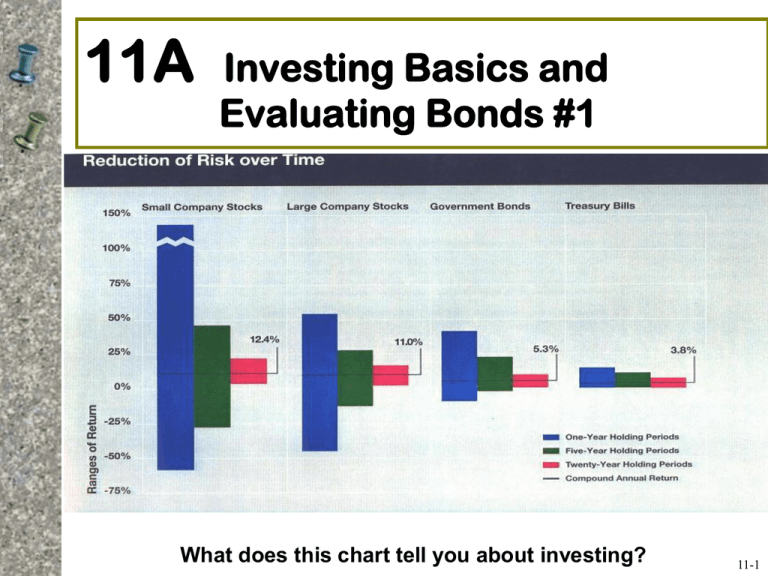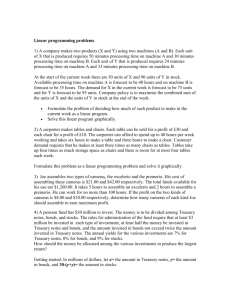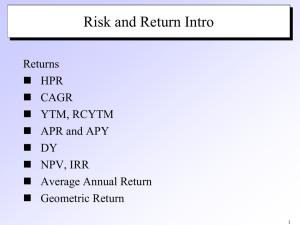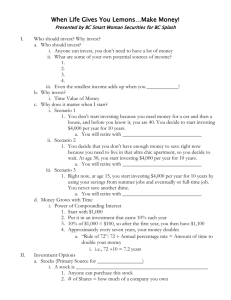Chapter 11a: Investing Basics and Evaluating
advertisement

11A Investing Basics and Evaluating Bonds #1 What does this chart tell you about investing? 11-1 Why People Invest • To achieve financial goals, such as the purchase of a new car, a down payment on a home, or paying for a child’s education. • To increase current income. • To gain wealth and a feeling of financial security. • To have funds available during retirement years. Objective 1 Explain Why You Should Establish an Investment Program Establishing Investment Goals • Financial goals should be: – Specific – Measurable – Tailored to your financial needs – Aimed at what you want to accomplish • Financial goals should be the driving force behind your investment plan 11-3 Establishing Investment Goals 1. What will you use the money for? 2. How much money do you need to satisfy your investment goals? 3. How will you obtain the money? 4. How long will it take you to obtain the money? 5. How much risk are you willing to assume in an investment program? 6. What possible economic or personal conditions could alter your investment goals? 7. Considering your economic circumstances, are your investment goals reasonable? 8. Are you willing to make the sacrifices necessary to ensure that you meet your investment goals? 9. What will the consequences be if you don’t reach your investment goals? 11-4 Performing a Financial Checkup • Work to balance your budget – Do you regularly spend more than you make? – Pay off high interest credit card debt first • Obtain adequate insurance protection • Start an emergency fund you can access quickly – Three months of living expenses • Have access to other sources of cash for emergencies – Pre-approved line of credit – Cash advance on your credit card 11-5 Surviving a Financial Crisis 1. Establish a larger than usual emergency fund 2. Know what you owe • Identify debts that must be paid 3. Reduce spending 4. Pay off credit cards 5. Apply for a line of credit at your bank, credit union, or financial institution 6. Notify credit card companies and lenders if you are unable to make payments 7. Monitor the value of your investment and retirement accounts 11-6 Getting the Money Needed to Start an Investing Program • Pay yourself first • Take advantage of employer- sponsored retirement programs • Participate in elective savings programs • Make a special savings effort one or two months each year • Take advantage of gifts, inheritances, and windfalls 11-7 The Value of Long-Term Investing Programs • Even small amounts invested regularly grow over a long period of time • If you begin saving $2,000 each year. depending on the rate of return, you could have over $1 million by the time you are age 65 (See Exhibit 11-1 on page 356) • The higher the rate of return, the greater the investment risk 11-8 Objective 2 Describe How Safety, Risk, Income, Growth, and Liquidity Affect Your Investment Decisions Factors Affecting the Choice of Investments • Safety and risk – Risk = uncertainty about the outcome – Investment Safety = minimal risk of loss – Risk-Return Trade-Off • The potential return on any investment should be directly related to the risk the investor assumes – Speculative investments are high risk, made by those seeking a large profit in a short time 11-9 Components of the Risk Factor • Inflation Risk during periods of high inflation, your investment return may not keep pace with inflation; lose purchasing power • Interest Rate Risk the value of bonds or preferred stock may increase or decrease with changes in interest rates • Business Failure Risk affects stocks and corporate bonds (when business is not profitable) • Market Risk the risk of being in the market versus in a risk-free asset (stocks follow market cycle) 11-10 Investment Income, Growth and Liquidity • Investment Income – A predictable source of income (dividends or interest) – Most conservative = passbook savings, CDs and government securities – Other choices: • • • • • • Municipal and corporate bonds Preferred stock Utility stocks Selected common stocks Selected Mutual funds Rental real estate 11-11 Investment Income, Growth and Liquidity • Investment Growth – – – • Growth in value (price appreciation) Common stock usually offers the greatest potential for growth Mutual funds and real estate offer growth potential Investment Liquidity – 2 Dimensions: • Ability to buy or sell investment quickly • Without substantially affecting the investment’s value • Bank accounts VERY liquid; CDs have penalties; stocks and bonds could lose money upon sale 11-12 Traditional Investment Evaluation Factors 11-13 Objective 3 Identify the Factors That Can Reduce Investment Risk Asset Allocation = The process of spreading your assets among several different types of investments (choose % weightings in each) • The ratio of stocks, bonds, cash assets, other securities in your portfolio (Conservative, Moderate, Aggressive portfolios with different asset weights: conservative portfolio = less stock) • Most important determinant of overall investment success = Diversification (“eggs in different baskets”) 11-14 Portfolio Management & Asset Allocation Other Factors to Consider: – Your Tolerance for Risk • At what point can you no longer sleep easily? • See http://njaes.rutgers.edu/money/riskquiz/ – Your Investment Time Horizon • When will you need the money? • How long can your money continue to grow? – Your Age • Growth vs. income (older people more conservative) • Recovery time if investments nosedive • One guideline: 110 – age = % of portfolio in stock 11-15 Your Role in the Investment Process 1. Evaluate potential Investments 2. Monitor the value of your investments 3. Keep accurate records 4. Other factors Seek help from personal financial planner Consider the tax consequences of selling investments 11-16 Objective 4 Understand Why Investors Purchase Government Bonds • Government bonds = written pledge to: – Repay a specified sum of money (face value) – At maturity – Along with periodic interest (coupon payments) • Sold to fund the national debt and the ongoing costs of government • Three levels of government issues: – Federal – State – Local municipalities 11-17 U.S. Treasury Bills, Notes and Bonds Treasury Bills (T-Bills) • • • • • $100 minimum 4, 13, 26 and 52 weeks to maturity Sold at a discount Federal, but no state, tax on interest earned “Reciprocal immunity” doctrine Treasury Notes • • • • • $100 units Typical maturities = 2, 3, 5, 7, and 10 years Interest paid every six months Higher rate than T-bills (Why?) Federal, but no state, tax on interest earned 11-18 U.S. Treasury Bills, Notes and Bonds Treasury Bonds • • • • Issued in minimum units of $100 30 year maturity dates Interest rates higher than Treasury notes & bills Interest paid every six months Treasury Inflation-Protected Securities (TIPS) • • • • Sold in minimum units of $100 Sold with 5, 10 or 20 year maturities Principal changes with inflation (measured by CPI) Pays interest twice a year at a fixed rate 11-19 Federal Agency Debt Issues • Essentially risk free • Slightly higher interest rates than Treasury securities (Why?) • Minimum investment may be as high as $10,000 to $25,000 • Maturities range from 1 – 30 years • Average maturity = 12 years • Issuing agencies sample: – – – – Fannie Mae Freddie Mac GNMA TVA 11-20 State and Local Government Securities Municipal Bonds (“Munis”) • Issued by a state or local government – – – – Cities Counties School districts Special taxing districts • Funds used for ongoing costs and to build major projects such as schools, airports, and bridges • General Obligation Bonds – Backed by the full faith, credit and taxing authority of the issuing state or local government • Revenue Bonds – Repaid from money generated by the project the funds finance, such as a toll bridge 11-21 State and Local Government Securities Municipal Bonds (“Munis”) • Key characteristics: – Interest exempt from federal taxes – Capital gains may NOT be tax exempt – Usually exempt from state and local taxes in state where issued – Exempt status determined by use of funds – Lower rate of return than on taxable bonds • Insured municipal bonds – Private insurance to reduce risk 11-22 Taxable Equivalent Yield Formula Used to compare tax-exempt and taxable bonds Tax - e xe m pt yield Taxable Equivale nt Yie ld 1 - Your tax rate Exam ple : .05 Taxable Equivale nt Yie ld .0694 6.94% 1 - .28 11-23 Wrap Up • Concept Check 11-1- Why Develop Specific Investment Goals? Why Participate in Employer Retirement Savings Plan? How the TVoM Affects Investing. • Exhibit 11-2- A Quick Test to Measure Investment Risk • Concept Check 11-2- Four Components of Risk • Concept Check 11-4- Taxable Equivalent Yields











